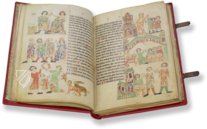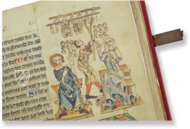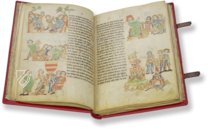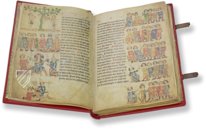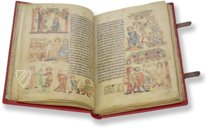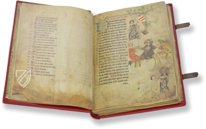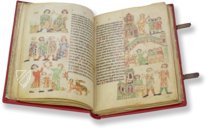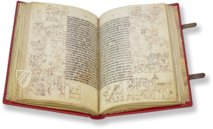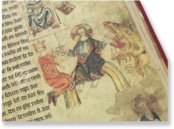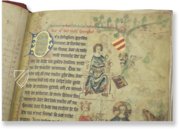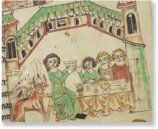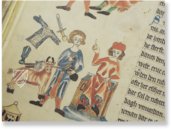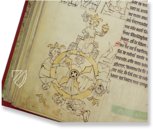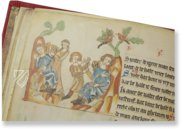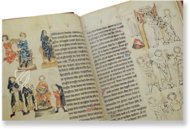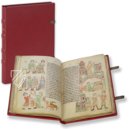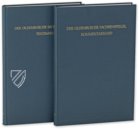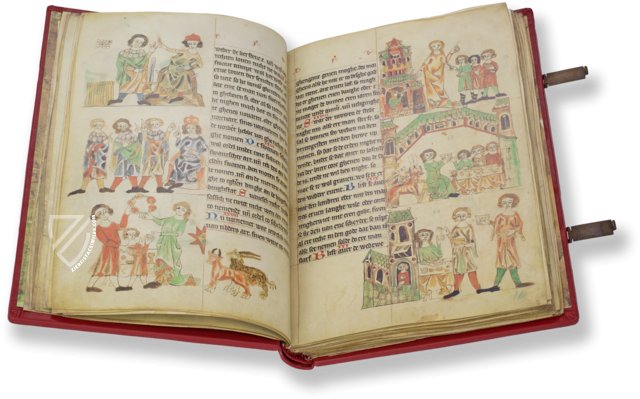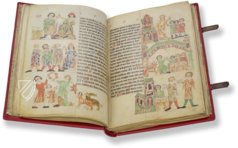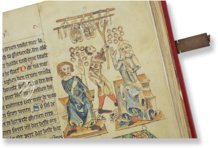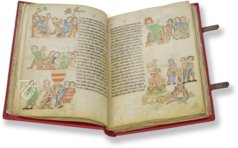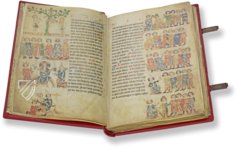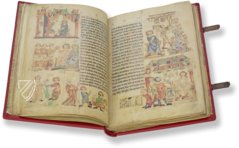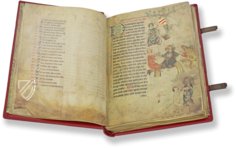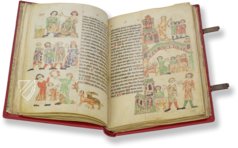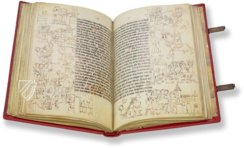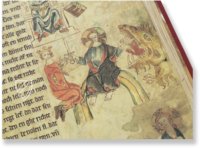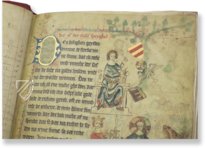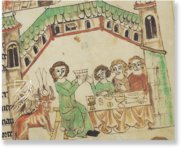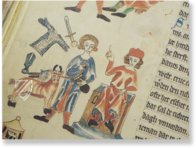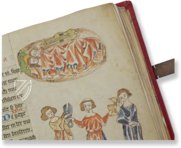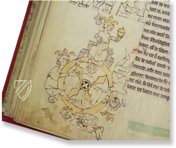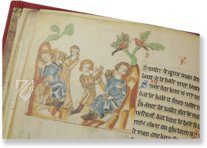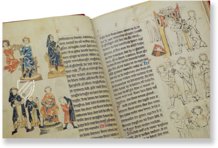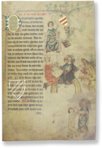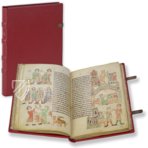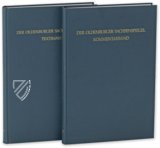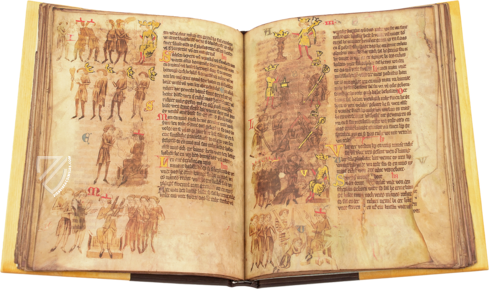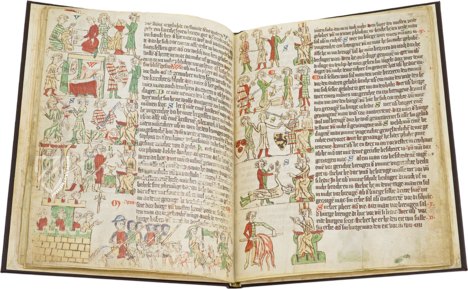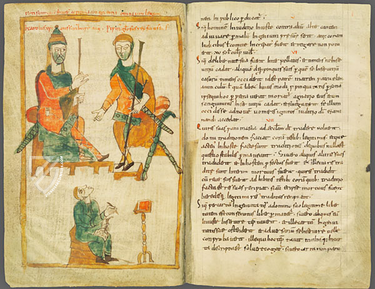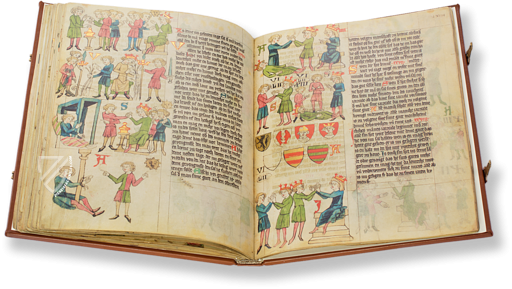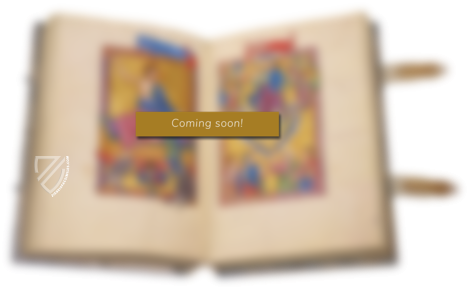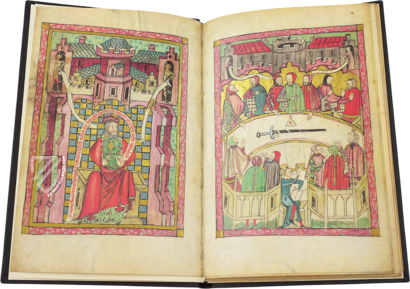Oldenburg Mirror of Saxony
(1,000€ - 3,000€)
The Oldenburg Mirror of Saxony stands out among the numerous various manifestations of the "Mirror of Saxony", one of the oldest works codifying medieval law, because it is one of a very few illustrated manuscripts whose illustrations are condensed in a special picture column and the only example of an illustrated text on territorial and feudal law. Written in German, the language of the people instead of Latin or Greek, it was commissioned by Count John III of Oldenburg to counter the increasing tendency toward uncertainty in legal matters. This document is actually a translation of a now lost Latin original, a copy of which was made for him in 1336 at Rastede Abbey. In addition to being an excellent source for the study of medieval German law, the wealth of miniatures contained therein represent one of the best sources of information on everyday life during that period.
Oldenburg Mirror of Saxony
The group of Mirror of Saxony texts belongs to the earliest works of medieval legal literature. Among more than 400 manuscripts and fragments of this type, the Oldenburg Mirror of Saxony constitutes a particular rarity, as it is one of a very few illustrated manuscripts whose illustrations are condensed in a special picture column and the only example of an illustrated text on territorial and feudal law. The significance of the Oldenburg Mirror of Saxony resides also in its immense value as a source of cultural history. Language, jurisdiction and popular culture, things that have been a part of our everyday lives, become tangible, showing plainly how our generation is rooted in a long gone past. The Oldenburg Mirror of Saxony contains records of applied law which is not written in one of the classical languages of the educated classes, Greek or Latin, but in the vernacular. The text was transcribed by Eike von Repgov from an original Latin version (now lost) into Middle Low German and copied by the Benedictine monk Hinrik Gloyesten in 1336 on the initiative of Count John III of Oldenburg in the Abbey of Rastede.
One of the Earliest Works of Medieval Specialist Literature
When John III ordered the recording of the law, he intended to counter the increasing tendency toward uncertainty in legal matters in his country. The committing to paper of formerly unwritten Saxon customary law was meant to meet the need for securing law and order in this uncertain period. In this respect, the integration of concrete, customary norms into a universal Christian view of the world was a priority. The fact that true Christian convictions were a matter of debate is best exemplified in the Mirror of Saxony: in a bill of 1374, Pope Gregory XI condemned 14 articles of the Mirror as heretical. The title of Mirror was chosen for this book of law because, like the mirror literature of the Middle Ages, it reflected part of the Christian conception of the world which had an exemplary character for a certain domain of life, in this case the legal domain.
A Unique Textbook
The Oldenburg Mirror of Saxony was destined for educational purposes and is of a didactic character, as its pictures and illustrations functioned as mnemonic technical aids. It describes all aspects of contemporary law, both the territorial and the feudal law in force at that period. The duties and rights of the individual within certain social circles, unmistakably phrased and enforced by religious and secular courts, form the starting point from which all further details are treated. The reader is thus instructed in legal matters in a very impressive manner. The instructive contents are supported by illustrations that are executed with great craftsmanship to accompany the text in a previously laid out picture column. These are either lavishly colored or simply outlined pen drawings. From folio 87, the illustration is interrupted and the picture strip remains empty whereas the text is decorated with numerous initials throughout. The script used for the Oldenburg codex is a Gothic textura, which was common for manuscripts of quality decoration. The script is of good and regular quality over long passages, thus betraying the hand of an experienced and diligent scribe. The text is generally very readable because of its broad ductus. In an essential aspect, the illustrations go well beyond the text: besides the typological patterns from which all medieval picture compositions are derived, they contain a wealth of details concerning everyday life of that period. The faithful and detailed depiction of clothes, utensils, arms, exterior and interior architectures as well as the postures and gestures of the figures in this code of law offer an inexhaustible source for research into everyday medieval life.
The Commentary Volume
A text volume encompassing the full transcription of the Middle Low German text and a translation by Werner Peters and Wolfgang Wallbraun accompanies the facsimile edition. It also comprises a codicological and palaeographic introduction by Wolfgang Milde. The comprehensive scholarly commentary was edited by Ruth Schmidt-Wiegand on the initiative of the Niedersächsische Sparkassenstiftung, Hannover and contains articles by reputed researchers who explain the manuscript and its background in all detail.
Codicology
- Alternative Titles
- Oldenburger Sachsenspiegel
- Size / Format
- 272 pages / 32.8 × 22.8 cm
- Origin
- Germany
- Date
- 1336
- Epochs
- Style
- Language
- Illustrations
- All pages illustrated alongside the text
- Patron
- Count John III of Oldenburg (1302–42)
- Artist / School
- Benedictine monk Hinrik Gloyesten (scribe)
Oldenburg Mirror of Saxony
Heerschildordnung
The six coats of arms shown here represent the so-called Heerschildordnung (order of the of the shields of knighthood) of the Holy Roman Empire. It is derived from a military hierarchy based on feudal law, which in the Sachsenspiegel takes on the significance of a division of medieval society. The first Heerschild (shield of knighthood) was the king or emperor as the supreme feudal lord. This was followed by the ecclesiastical Princes of the Empire, the secular Princes of the Empire, the counts and free lords, the so-called Schöffenbarfreien, feudatories of the free lords and ministerials and finally their vassals in the sixth Heerschild. A seventh Heerschild remains undefined and is only slightly outlined in the marginal illumination. Eike von Repgow does not explicitly classify peasants and townspeople in this social order.
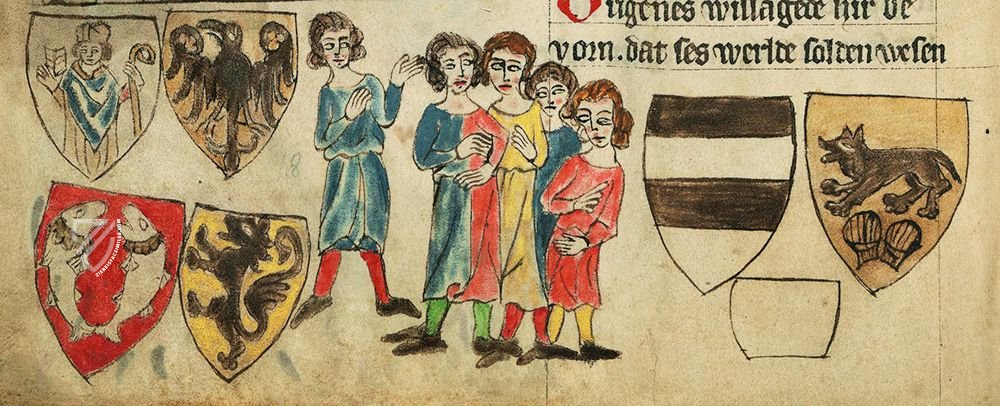
Oldenburg Mirror of Saxony
Author Portrait / Landrecht
This page, the beginning of the section on Landrecht or “customary law”, also has a portrait of the author – Eike von Repgow. He is seated on a throne and flanked by his coat of arms – horizontal stripes of red and gold – as a dove with a halo, representing the inspiration of the Holy Spirit, drops the manuscript he is about to write in his lap.
Below we see an image of a serene, perhaps even happy Christ holding a sword in one hand and making a sign of benediction in the other. He sits between a king and a monster with another grotesque in its mouth, perhaps a symbol of the Hellmouth. This and the image of Christ blessing a naked sinner represent the God-given order of the universe in combination with the mercy of his son.
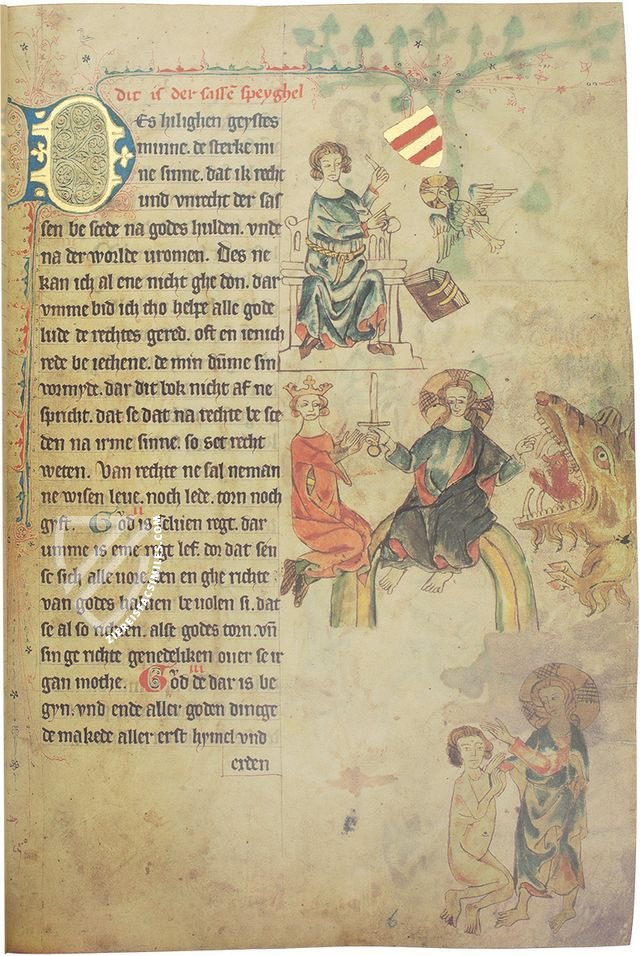
#1 Der Oldenburger Sachsenspiegel
Language: German
(1,000€ - 3,000€)
- Treatises / Secular Books
- Apocalypses / Beatus
- Astronomy / Astrology
- Bestiaries
- Bibles / Gospels
- Chronicles / History / Law
- Geography / Maps
- Saints' Lives
- Islam / Oriental
- Judaism / Hebrew
- Single Leaf Collections
- Leonardo da Vinci
- Literature / Poetry
- Liturgical Manuscripts
- Medicine / Botany / Alchemy
- Music
- Mythology / Prophecies
- Psalters
- Other Religious Books
- Games / Hunting
- Private Devotion Books
- Other Genres
- Afghanistan
- Armenia
- Austria
- Belgium
- Belize
- Bosnia and Herzegovina
- China
- Colombia
- Costa Rica
- Croatia
- Cyprus
- Czech Republic
- Denmark
- Egypt
- El Salvador
- Ethiopia
- France
- Germany
- Greece
- Guatemala
- Honduras
- Hungary
- India
- Iran
- Iraq
- Israel
- Italy
- Japan
- Jordan
- Kazakhstan
- Kyrgyzstan
- Lebanon
- Liechtenstein
- Luxembourg
- Mexico
- Morocco
- Netherlands
- Palestine
- Panama
- Peru
- Poland
- Portugal
- Romania
- Russia
- Serbia
- Spain
- Sri Lanka
- Sweden
- Switzerland
- Syria
- Tajikistan
- Turkey
- Turkmenistan
- Ukraine
- United Kingdom
- United States
- Uzbekistan
- Vatican City
- A. Oosthoek, van Holkema & Warendorf
- Aboca Museum
- Ajuntament de Valencia
- Akademie Verlag
- Akademische Druck- u. Verlagsanstalt (ADEVA)
- Aldo Ausilio Editore - Bottega d’Erasmo
- Alecto Historical Editions
- Alkuin Verlag
- Almqvist & Wiksell
- Amilcare Pizzi
- Andreas & Andreas Verlagsbuchhandlung
- Archa 90
- Archiv Verlag
- Archivi Edizioni
- Arnold Verlag
- ARS
- Ars Magna
- ArtCodex
- AyN Ediciones
- Azimuth Editions
- Badenia Verlag
- Bärenreiter-Verlag
- Belser Verlag
- Belser Verlag / WK Wertkontor
- Benziger Verlag
- Bernardinum Wydawnictwo
- BiblioGemma
- Biblioteca Apostolica Vaticana (Vaticanstadt, Vaticanstadt)
- Bibliotheca Palatina Faksimile Verlag
- Bibliotheca Rara
- Boydell & Brewer
- Bramante Edizioni
- Bredius Genootschap
- Brepols Publishers
- British Library
- C. Weckesser
- Caixa Catalunya
- Canesi
- CAPSA, Ars Scriptoria
- Caratzas Brothers, Publishers
- Carus Verlag
- Casamassima Libri
- Centrum Cartographie Verlag GmbH
- Chavane Verlag
- Christian Brandstätter Verlag
- Circulo Cientifico
- Club Bibliófilo Versol
- Club du Livre
- CM Editores
- Collegium Graphicum
- Collezione Apocrifa Da Vinci
- Comissão Nacional para as Comemorações dos Descobrimentos Portugueses
- Coron Verlag
- Corvina
- CTHS
- D. S. Brewer
- Damon
- De Agostini/UTET
- De Nederlandsche Boekhandel
- De Schutter
- Deuschle & Stemmle
- Deutscher Verlag für Kunstwissenschaft
- DIAMM
- Droz
- E. Schreiber Graphische Kunstanstalten
- Ediciones Boreal
- Ediciones Grial
- Ediclube
- Edições Inapa
- Edilan
- Editalia
- Edition Deuschle
- Edition Georg Popp
- Edition Leipzig
- Edition Libri Illustri
- Editiones Reales Sitios S. L.
- Éditions de l'Oiseau Lyre
- Editions Medicina Rara
- Editorial Casariego
- Editorial Mintzoa
- Editrice Antenore
- Editrice Velar
- Edizioni Edison
- Egeria, S.L.
- Eikon Editores
- Electa
- Emery Walker Limited
- Enciclopèdia Catalana
- Eos-Verlag
- Ephesus Publishing
- Ernst Battenberg
- Eugrammia Press
- Extraordinary Editions
- Fackelverlag
- Facsimila Art & Edition
- Facsimile Editions Ltd.
- Facsimilia Art & Edition Ebert KG
- Faksimile Verlag
- Feuermann Verlag
- Folger Shakespeare Library
- Franco Cosimo Panini Editore
- Friedrich Wittig Verlag
- Fundación Hullera Vasco-Leonesa
- G. Braziller
- Gabriele Mazzotta Editore
- Gebr. Mann Verlag
- Gesellschaft für graphische Industrie
- Getty Research Institute
- Giovanni Domenico de Rossi
- Giunti Editore
- Graffiti
- Grafica European Center of Fine Arts
- Guido Pressler
- Guillermo Blazquez
- Gustav Kiepenheuer
- H. N. Abrams
- Harrassowitz
- Harvard University Press
- Helikon
- Hendrickson Publishers
- Henning Oppermann
- Herder Verlag
- Hes & De Graaf Publishers
- Hoepli
- Holbein-Verlag
- Houghton Library
- Hugo Schmidt Verlag
- Idion Verlag
- Il Bulino, edizioni d'arte
- ILte
- Imago
- Insel Verlag
- Insel-Verlag Anton Kippenberger
- Instituto de Estudios Altoaragoneses
- Instituto Nacional de Antropología e Historia
- Introligatornia Budnik Jerzy
- Istituto dell'Enciclopedia Italiana - Treccani
- Istituto Ellenico di Studi Bizantini e Postbizantini
- Istituto Geografico De Agostini
- Istituto Poligrafico e Zecca dello Stato
- Italarte Art Establishments
- Jan Thorbecke Verlag
- Johnson Reprint Corporation
- Josef Stocker
- Josef Stocker-Schmid
- Jugoslavija
- Karl W. Hiersemann
- Kasper Straube
- Kaydeda Ediciones
- Kindler Verlag / Coron Verlag
- Kodansha International Ltd.
- Konrad Kölbl Verlag
- Kurt Wolff Verlag
- La Liberia dello Stato
- La Linea Editrice
- La Meta Editore
- Lambert Schneider
- Landeskreditbank Baden-Württemberg
- Leo S. Olschki
- Les Incunables
- Liber Artis
- Library of Congress
- Libreria Musicale Italiana
- Lichtdruck
- Lito Immagine Editore
- Lumen Artis
- Lund Humphries
- M. Moleiro Editor
- Maison des Sciences de l'homme et de la société de Poitiers
- Manuscriptum
- Martinus Nijhoff
- Maruzen-Yushodo Co. Ltd.
- MASA
- Massada Publishers
- McGraw-Hill
- Metropolitan Museum of Art
- Militos
- Millennium Liber
- Müller & Schindler
- Nahar - Stavit
- Nahar and Steimatzky
- National Library of Wales
- Neri Pozza
- Nova Charta
- Oceanum Verlag
- Odeon
- Orbis Mediaevalis
- Orbis Pictus
- Österreichische Staatsdruckerei
- Oxford University Press
- Pageant Books
- Parzellers Buchverlag
- Patrimonio Ediciones
- Pattloch Verlag
- PIAF
- Pieper Verlag
- Plon-Nourrit et cie
- Poligrafiche Bolis
- Presses Universitaires de Strasbourg
- Prestel Verlag
- Princeton University Press
- Prisma Verlag
- Priuli & Verlucca, editori
- Pro Sport Verlag
- Propyläen Verlag
- Pytheas Books
- Quaternio Verlag Luzern
- Reales Sitios
- Recht-Verlag
- Reichert Verlag
- Reichsdruckerei
- Reprint Verlag
- Riehn & Reusch
- Roberto Vattori Editore
- Rosenkilde and Bagger
- Roxburghe Club
- Salerno Editrice
- Saltellus Press
- Sandoz
- Sarajevo Svjetlost
- Schöck ArtPrint Kft.
- Schulsinger Brothers
- Scolar Press
- Scrinium
- Scripta Maneant
- Scriptorium
- Shazar
- Siloé, arte y bibliofilia
- SISMEL - Edizioni del Galluzzo
- Sociedad Mexicana de Antropología
- Société des Bibliophiles & Iconophiles de Belgique
- Soncin Publishing
- Sorli Ediciones
- Stainer and Bell
- Studer
- Styria Verlag
- Sumptibus Pragopress
- Szegedi Tudomànyegyetem
- Taberna Libraria
- Tarshish Books
- Taschen
- Tempus Libri
- Testimonio Compañía Editorial
- Thames and Hudson
- The Clear Vue Publishing Partnership Limited
- The Facsimile Codex
- The Folio Society
- The Marquess of Normanby
- The Richard III and Yorkist History Trust
- Tip.Le.Co
- TouchArt
- TREC Publishing House
- TRI Publishing Co.
- Trident Editore
- Tuliba Collection
- Typis Regiae Officinae Polygraphicae
- Union Verlag Berlin
- Universidad de Granada
- University of California Press
- University of Chicago Press
- Urs Graf
- Vallecchi
- Van Wijnen
- VCH, Acta Humaniora
- VDI Verlag
- VEB Deutscher Verlag für Musik
- Verlag Anton Pustet / Andreas Verlag
- Verlag Bibliophile Drucke Josef Stocker
- Verlag der Münchner Drucke
- Verlag für Regionalgeschichte
- Verlag Styria
- Vicent Garcia Editores
- W. Turnowski Ltd.
- W. Turnowsky
- Waanders Printers
- Wiener Mechitharisten-Congregation (Wien, Österreich)
- Wissenschaftliche Buchgesellschaft
- Wissenschaftliche Verlagsgesellschaft
- Wydawnictwo Dolnoslaskie
- Xuntanza Editorial
- Zakład Narodowy
- Zollikofer AG




